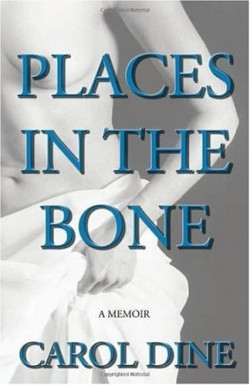Places in the Bone
A Memoir
“Dear Mother, I will not write about someone else’s family,” writes the author. Though terror and struggle recur in her life with frightening frequency, she will not prune the story to make it easier to reconcile, to show herself in a better light, to absolve the innocent and guilty. Neither will she ask for pity, nor make excuses. Sifting through her life with her poet’s attention, Dine creates a startlingly honest exploration that longs to find the truth.
Dine, who teaches writing at Suffolk University, has published two collections of poetry, Trying to Understand the Lunar Eclipse and Naming the Sky. Coming from a lineage besieged by cancer, she has battled the disease herself three times, and now gives speeches on surviving breast cancer while wearing an electric blue wig. As a child, she was the outlet for her father’s rage. He beat her physically and cut her down psychologically, while her mother and sister addressed the abuse with silence. As an adult, she perpetuated her father’s abuse in variation through other men, and nightmarishly with her own son. This memoir moves through all these discrete stories, but also beyond, to approach the ineffable aspects of life, love, and fear, and how one woman comes to know herself.
Set up in chapters, the book functions as a collage, with poems, images, and journal entries pinned together. Scenes and decades shift and recur in an associative manner. In the chapter called “Treatments,” Dine quickly moves from an early fumbled date after her lumpectomy to a harrowing beating at age twelve that almost causes her to lose consciousness. The two moments are placed close together, like paintings in a gallery to interact in the viewer. At the big jumps within chapters, Dine places time markers, but these are difficult to track. The narrative becomes for the reader as it is for the author—memories at once distant and immediate, past and present constantly informing each other.
Compression is one principle of poetry that Dine carries through to the prose line. The tendency towards efficiency remains, creating a clipped and compact texture. The themes of this memoir are as huge as planets, but Dine relies on the accretion of sketches and the power of a well-placed metaphor to say in a breath what would take others hours. For example, describing the moment when technicians are using a nuclear tracer to map her body, she writes, “It’s Orwell’s 1984. From a monitor behind the wall, they’re watching inside me. I’m phosphorescent. Lit up like an underground city.” It is an eerily beautiful image loaded with the anxiety of waiting to hear if she has cancer again. Overwhelmingly, Dine’s tone is that of an observer, a separation trick that she discovered in childhood as a way to survive the beatings. It can create a chilling, clinical effect, but often affords her the distance necessary to confront and discuss some of the more difficult passages.
Though the exterior narrative deals with her father’s abuse and her struggle with cancer, the internal concern of the memoir is how and why she is a writer. Everything pulls into her discovery of her writing. “I write to exert my will. I write to survive illness, all my losses,” she writes in “The Locked Box.” “The act of writing keeps me alive.” Having waited until age thirty to pursue writing seriously, she found an urgency of dammed-up words, which she describes in “The Woman in My Poem.”
She sends poems to Anne Sexton, who gives her an early affirmation of her talent and invites Dine into her workshop. In a later essay, Dine shares her discovery that Stanley Kunitz is a relative and the nurturing presence he becomes. By analyzing her evolution from childhood journals to published author and college instructor, she comes to a crucial understanding of how writing gives her ownership over her life: “Some things stay imprinted on the memory and cannot be erased or forgiven. Yet there is a difference between what has been passed down to me and what I transform through writing and give back.”
It is easy to say that Places in the Bone is an inspiring read about survival and the passion of one woman for healing her life. More difficult to phrase is the mineral truth that filters out of her decades-long meditation about how to live with an aim towards honesty and how readers can see themselves and others in a full light. Brave and earnest, this book is an excellent place to launch one’s own exploration.
Disclosure: This article is not an endorsement, but a review. The publisher of this book provided free copies of the book to have their book reviewed by a professional reviewer. No fee was paid by the publisher for this review. Foreword Reviews only recommends books that we love. Foreword Magazine, Inc. is disclosing this in accordance with the Federal Trade Commission’s 16 CFR, Part 255.

